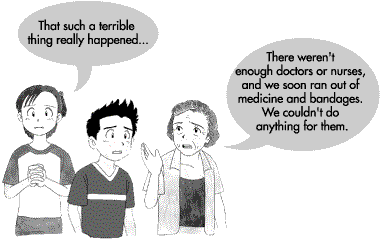 |
| Tragic Situation in the Quarantine Station |
|
|||||||||||||||
|
|||||||||||||||
|
| The Closing of the Emergency Field Hospital, then the Quarantine Station |
| The emergency field hospital was open from August 6 to 25. During that time, an estimated 10,000 patients were received into the Ninoshima Quarantine Station. Eyewitnesses state that bodies were also transported from Ujina, Kanawajima Island, and Koi for disposal on Ninoshima, but no accurate numbers are available. The quarantine station was a military facility. It was not designed for the long-term care of patients. Beginning about August 12, survivors were transferred to Itsukaichi, Hatsukaichi, Miyajima Island, Otake, and other towns and villages around the periphery of Hiroshima. On August 25, over 500 patients remained on Ninoshima. Then Hiroshima Prefectural employees transported them to other hospitals and the emergency hospital was closed. The Ninoshima Quarantine Station had been a military facility since the Sino-Japanese War, but in 1946 it came under the Repatriates Relief Bureau of the Ministry of Health and Welfare. Later it became Ujina Quarantine Station, then the Hiroshima Quarantine Station, continuing to perform quarantine tasks under the Ministry of Health and Welfare. In 1958, the buildings were deemed unusably deteriorated, and the quarantine station, too, was closed. |
 |
54 I received some ashes from an unknown junior high student and treated them as the remains of my own child Drawing and text / Tomiko Miyaji September 15, 1945, Hiroshima City Hall "I heard that he was taken to Ninoshima. I went to the island. No trace of anyone. I went to City Hall and searched through the ledger of victims who had been on Ninoshima. That ledger had only one entry that read, "First-year, Second Hiroshima Prefectural Junior, name unknown." I thought it might be my child, so I took a small handful of ashes out of the box and wrapped them in a dirty handkerchief. When I think that this spine might be too big for a child, I can't help but cry." Excerpt from explanation in drawing |
|
Ninoshima and the Atomic Bombing
Island of Final Rest Military City Hiroshima and the Ninoshima Quarantine Station Atomic Bombing Relief Activities Immediately after the Bombing Ninoshima Overflowing with Injured Anguished Voices Calling for Water; Family Members Searching for Loved Ones Sending off the Dead The Closing of the Emergency Field Hospital, then the Quarantine Station A-bomb Orphans Ninoshima of the Sleeping Dead Conclusion Return to TOP |


 47
47





